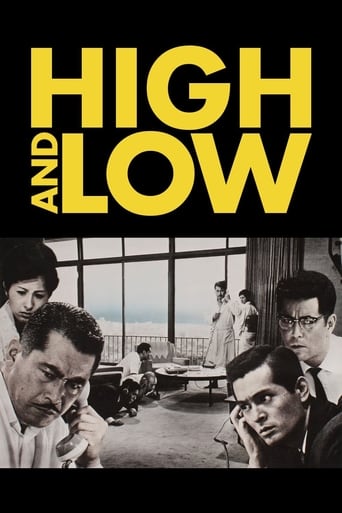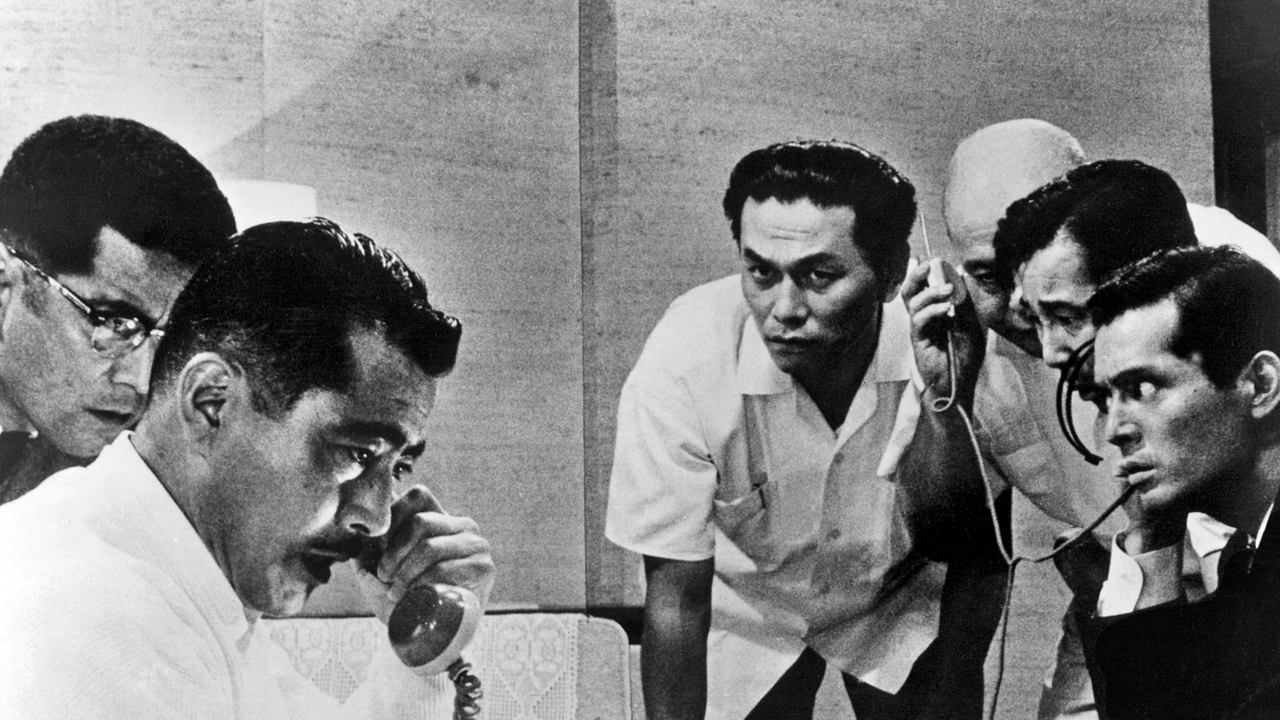Don Gordon
Kurosawa was known as a great humanist, and ethical questions clearly play a central role in each thread of the plot. Kingo Gondo (played by Toshiro Mifune) is a director on the board of a company called National Shoes. He is approached by three other directors, who want to overthrow the current president, and start producing a new line of shoes. Gondo agrees that the president is old-fashioned, but he rejects the shoes they show him as shoddily made. He ejects them from his house, only to get a phone call from a kidnapper who claims to have taken his son. His son turns up, but his friend the chauffeur's son is gone. Even after the kidnapper realizes his mistake, he insists that the ransom still be paid. Gondo had been planning to use the money to fight off the take-over bid, so the police immediately wonder if the other directors have orchestrated the kidnapping in order to deprive Gondo of the cash he needs to stop them. The chauffeur, Gondo's wife and the police are all reticent to put too much pressure on Gondo to pay the ransom, but it is clear he must make a choice: to save the boy or fend off the take-over.In the second half, the police investigation is driven on by their sympathy for Gondo and their desire to see the culprit punished for all of his crimes. There is also a class struggle subtext with Gondo living in a quiet mansion on a hill and the kidnapper in a tiny room below.The cast of High and Low was truly star-studded. Mifune, Takashi Shimura, Isao Kimura and Minoru Chiaki were among the Seven Samurai, and the lead detective here Tatsuya Nakadai had a leading role in both Sanjuro and Yojimbo. The kidnapper is played by Tsutomu Yamazaki who would go on to star in Juuzo Itami's Tampopo. Future Mito Komon lead Eijirou Touno even has a cameo as a factory worker.The film is in black and white, but Kurosawa has a wonderful eye for arresting visuals, and the story is tense and absorbing to the end. A classic.
MortalKombatFan1
"High and Low" is a Japanese hostage police drama that follows Kingo Gondo (Toshiro Mifune), the executive of a successful shoe manufacturer who is extorted for 30 million yen when the son of his chauffeur is kidnapped and held for ransom - the only problem is that he can't risk losing the money, otherwise he'll slump into debt, having put all his possession up for collateral in order to buy the majority of shares and maintain order in his company.The movie is over two hours long, split into two parts and is masterfully directed by Kurosawa, using deep focus photography, multiple camera setups, long takes (the longest being 9 minutes and 50 seconds) and his skillful blocking of the actors to get the most out of their performances.The first 50 or so minutes take place inside Gondo's house, the kidnapper on the phone making demands and the police trying to reason with him. Toshiro Mifune has a difficult choice to make and you can really see why he's one of the great actors in film with these scenes - his facial expressions and body language tell you everything about his internal struggle to choose between the safety of his employee's son, or the well being of his family.The movie's then followed by a brilliant train sequence that was done in two takes, had eight cameras filming at once and a hundred extras on board! Kurosawa definitely knew how to stage a scene to make the most out of his resources cinematically.The final part is a police procedural, with every finite detail being included in the large scale investigation. Just like the rest o the movie, it's all very exciting and expertly crafted."High and Low" is one of Akira Kurosawa's best films and one of the best movies ever made, crime flick or otherwise.
Sergeant_Tibbs
Even though Akira Kurosawa is mostly associated for his samurai classics, I'm really not a fan of them, besides his later opus Ran. I admire many of Kurosawa's techniques but I don't connect. High and Low is the first of his modern day films I've seen since Ikiru many years ago and although they're as respected but not as popular as his samurai films, I think I've found the niche where I love Kurosawa. The first hour is set in one place, boasting a riveting moral dilemma ripe for the textbooks. It's a fascinating psychological study to watch how protagonist Mr. Gondo's behaviour differs between the threat of holding his son hostage to the actual threat of holding an employee's son hostage, thanks to Toshiro Mifune's great performance. No matter what way the character plays it from there, the damage is already done and his vulnerability is revealed. It kind of makes you glad you aren't rich. This first half is ready for a stage adaptation and I wish it was the whole film as it relieves the tension mid-way. The rest of the film is a police procedural following the investigation to catch the extortionist. It's interesting and engaging but not quite as compelling. The film would have benefited from not skipping round its ensemble too much, especially after committing to Mr. Gondo at first so much. I would have also liked to have known more about the antagonist's motivation outside of a case of class jealousy, but I guess that was the point that the film was trying to illustrate. High and Low is still an essential entry in Kurosawa's canon, one that set the bar and foundation for cop thrillers to come.8/10
paleiff
Though High and Low is a great film in its own right and a shining example of Akira Kurosawa's genius and the success of this structural experiment, the stunningly canvassed characters with their layers and depth, wonderful performances, fluid camera-work and beautifully lit sets. The film does not rank amongst the best of Kurosawa's body of work; the ending in many ways felt unresolved or at least resolved to an extent but in an unsatisfying manner. Gondo makes the choice which he feels is the moral decision and gives away all he owns to save another's child and forgoes his opportunity to own the company he has given his blood, sweat and tears to. Even though the boy lives, they catch the kidnappers and most of Gondo's money is recovered and returned to him, it's not enough. His house and all of his belongings are repossessed and he has to start all over again. But in saying that isn't that Kurosawa's point? How much do we actually need, how much is enough and how much of what we own and posses is just overindulgence? The social commentaries made by Kurosawa fifty years ago still ring true today in the modern economic climate. Lessons can be taken from the film through both perspectives of the class spectrum; the rich would not exist without the poor and vice verse. But if equality is ever to be reached society must find a way to bridge the gap between the class', perhaps if the wealthy took a a page from Gondo's book and made a sacrifice that would be a start.


 AD
AD






